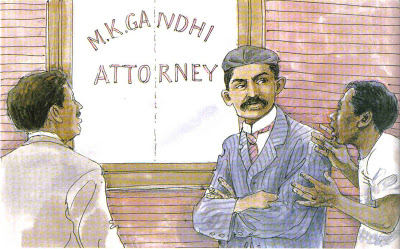A British and South African Perspective on Our Books – Part 2

 Our hardworking interns Naomi and Amani have become master reviewers during their internship with us. They have actually managed to review 170 of our books. Yes, yes… you read that right.. 170 titles! Phew!! So, we decided to share their perspectives (Naomi’s British perspective and Amani’s South African perspective) on our books.
Our hardworking interns Naomi and Amani have become master reviewers during their internship with us. They have actually managed to review 170 of our books. Yes, yes… you read that right.. 170 titles! Phew!! So, we decided to share their perspectives (Naomi’s British perspective and Amani’s South African perspective) on our books.Naomi says….
This book is dedicated to and is entirely about the life of Gandhi. From the outset it is clear that it is a very India-specific account of Gandhi and his life, speaking directly to an Indian audience: “We have his picture on our stamps and rupee notes and we get a holiday on his birthday.” Similarly, as early on as the first page there are several references that would be lost on a British audience: “faqir”, “dhoti”, “chappals”, “khadi chaddar” etc. However despite this, I still think that it is culturally relevant and could be read and enjoyed by a British audience. It is primarily an educational book about Gandhi, so it makes sense that whilst learning about him the reader should also learn some new words or phrases, and although this may require them to look words up it will add to how much they learn from the book overall. I also think that the personal way in which the book is written adds a lot to the effect, and can be appreciated even by people who are not Indian, as well as drawing their attention further to just how important Gandhi is to the Indian nation.
The narrative takes the reader through Gandhi’s life, outlining all the main events, as well as extra information provided in boxes throughout the book which contain stories not relevant to the main narrative but very relevant to the story of Gandhi’s life as a whole. The language used is plain and simple, which is important for two reasons. Firstly it is important in not distracting from the meaning of the text. It is also important in symbolising the plain and simple life that Gandhi lived, as is stated in the text: “he lived very simply.” At the end of the book there are two sections named “’Gandhigiri’ across the world!” and “Freedom Facts” which are very useful in putting Gandhi’s story into more context. The first gives information about influential people who Gandhi has inspired, and the second gives facts about Gandhi and other people who worked with him during the struggle. There is also a timeline of Gandhi’s life. The illustrations of the book are very varied, drawn in different styles, and some photos are also included. Overall it is a really great book, definitely one of the highlights of the Pratham Books range, giving a comprehensive account of some of the key events in Gandhi’s life accompanied by some lesser known facts and stories about him.
By adding a section talking about those who he influenced, it communicates a full picture of how he changed the world. The strength of the book is that it is just as enjoyable as it is informative, and even people who know quite a lot about Gandhi’s life are bound to learn something from it. “A Man Named Bapu” is very much aimed at an Indian-audience and most suited for this target readership, but I feel that anyone can learn from it. Indeed, the less you know about Gandhi or India in the first place, the more you can learn. Because of the way in which it directly addresses the reader as an Indian it will not be as enjoyable for a Briton to be read, but it will still be just as educational. A lot of the book’s charm comes from the fact it is written so personally and children from Britain, and equally elsewhere in the world, will appreciate both this and the opportunity to learn about Gandhi in such a simple and easy to follow way.
Amani shares his thoughts on the book:
A fantastic book about the history of the great leader Mahatma Gandhi, it captures the essence of this strong political leader. The book contains historical facts about where he came, and how he got to the point of fulfilling India’s independence. The book captures his teachings, his overall personality and what a relentless leader he was. The book storyboard and historical basis provide a good read for younger readers. The tale starts from when Gandhi was a child to rising up and becoming a liberal fighter for all people in India. It also provides additional information which gives the reader a total view about this once great leader. The illustrations are magnificent, the use of tones and colors create an almost realistic Gandhi. The illustrations work well with the content of the book and is very relevant to the language being used. Even the footnotes, which provide additional information, are clearly defined and well presented. The language is as clear as crystal! It does not over or vaguely describe the characteristics and history Gandhi had written for India and is precise. Even the other section titled “GANDHIGIRI: ACROSS THE WORLD”, applies a more in depth approach to the book, locating all the freedom leaders in the world (well most of them). With regard to a SouthAfrican tradition, it makes for an interesting read. Such a prominent figure needs to known and thus it is very important that he is shown to all communities.
You can read their first review here. If you have read the book and wish to share your review, please email us at web(at)prathambooks(dot)org or leave a message in the comments.






